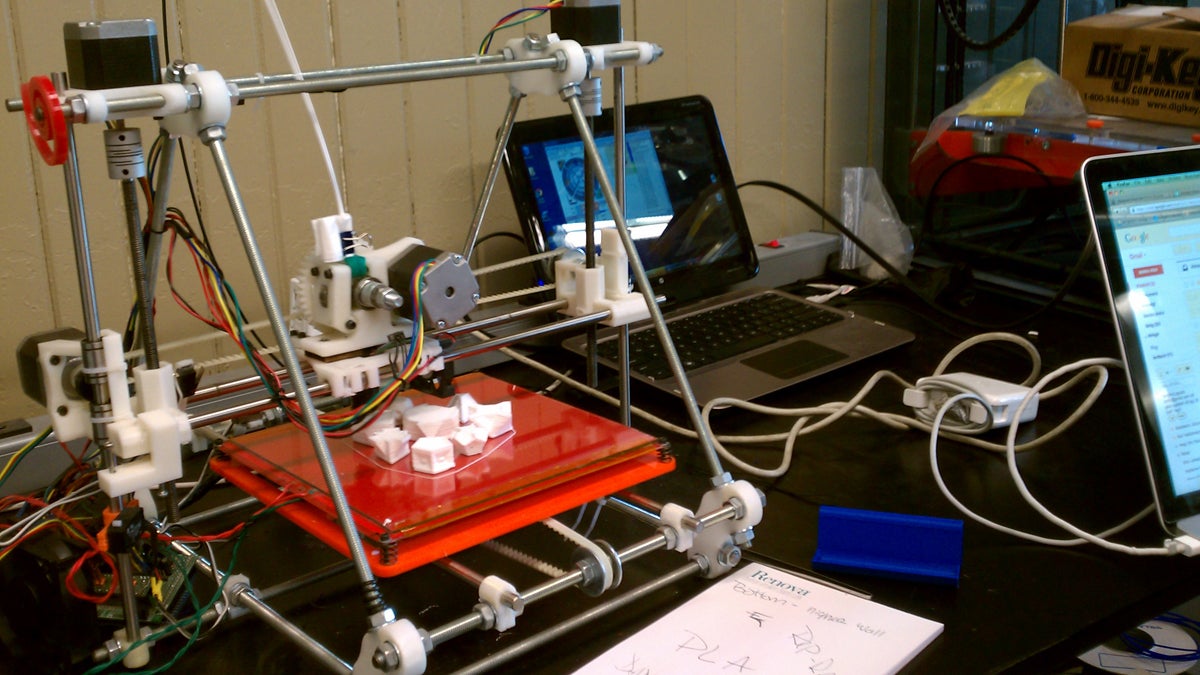NextFab Studio points ‘due north’ pairing print artists from Iceland and Philly

Kolbeinn Hugi, a visiting artist from Reykjavik, Iceland, is using a 3-D printer to make crystal shapes for the 'Due North' exhibit. (Peter Crimmins/WHYY)
Philadelphia artist Marianne Bernstein says it’s not ice that gets you in Iceland. It’s wind — the inspiration behind her “50 Words for Wind,” part of an exhibit of 13 Icelandic artists and 13 American artists (most from Philadelphia) opening Jan. 9 at the Crane Arts Building in Kensington.
Marianne Bernstein has visited Iceland seven times in the last three years. She says it’s not ice that gets you in Iceland. It’s wind.
“I remember my first visit, the wind was so strong. The wind practically blew me into the street. I had to hold onto a light pole,” said the artist and curator, noting that Icelanders check online wind forecasts just as Philadelphians click for rain.
“Mothers are worried about their babies blowing away. Tourists get blown into the sea,” she said. “It’s not a joking matter.”
Bernstein learned the Icelandic language has 50 words for “wind.” That’s the title of the piece she’s collaborating on with an Icelandic artist — “50 Words for Wind” — using an obsolete recording technology of magnetic strips printed on heavy cardstock.
It will be included in “Due North,” a show curated by Bernstein featuring 13 Icelandic artists and 13 American artists (most from Philadelphia) opening Jan. 9 at the Crane Arts Building in Kensington. the Icelanders visited the U.S. and the Americans traveled to Iceland to make their respective pieces.
“Due North” is presented by Philagrafika, a print-art organization that put together the ambitious Philagrafika 2010 three years ago. That festival — intended to be a regular event — exploded the idea of “print” into a vast array of imaginative techniques, but shortly after Philagrafika 2010 closed, the organization ran into money problems and severely downsized, maintaining only occasional portfolio exhibitions. “Due North” will be Philagrafika’s first major show since the festival.
Reassembling pieces of a dream
Artist Kolbeinn Hugi, a video and performance artist from Reykjavik, came to the NextFab design studio on Washington Avenue in South Philadelphia to experiment with 3-D printers. Last week he made a series of crystal shapes out of plastic, which will be used as part of an altered electronic synthesizer in an interactive sound and light installation.
The idea came to him in a dream where he was talking to the early-20th century American psychic Edgar Cayce, a proto-patriarch of the New Age movement. In the dream, Cayce showed Hugi crystals that acted as portals to a nonmaterial world.
Upon waking, Hugi realized the crystals had a shape that could not exist in reality. “You hear in your dreams and you see in your dreams, and you also have sensations — you have fear or awe,” said Hugi. “You can’t burn that to a digital file. You can’t make awe.”
Using a 3-D printer, a sound synthesizer, and video graphics, he aims to mimic the intention of the dream-logic crystals.
Hugi had never used a 3-D printer before, nor had he been to Philadelphia. The “Due North” exchange allowed him to travel into an unknown territory – physically and creatively – to figure out new approaches to his art.
Exploring a world of 3-D possibilities
Another participating artist Hrafnhildur Arnardottir, based in New York since 1994 (she goes by “Shoppy” because somebody once misheard her name as “shoplifter”), was at NextFab using a 3-D printer to make a branching network of plastic fibers, like a nervous system. She plans to use it as a basis for a sculpture made of human hair.
“I’m interested in the microscopic inner world of our body, and how it’s a replica of the outer world,” said Arnardottir. “There’s a repetition of form. It’s mind-blowing to me how’s it’s connected.”
Arnardottir describes herself as “analog” and “computer challenged,” but sees a world of possibilities opening up with the 3-D printer. She is pushing the machine to the breaking point.
“She had a file that wasn’t going to work with one of the machines, and she understood that. But she wanted to see what kind of mayhem the machine would create,” said Brandon Boulden, manager of 3-D processing at NextFab, who encourages this kind of thinking. “Though she understood the process, she wanted to challenge it, to see what it could do and what it would fail at.”
Like Hugi, Arnardottir is beginning to imagine things that do not exist in physical reality. For her next project, she is kicking around the idea of working with an MRI scan of her own brain.
“It would be a portrait of a thought,” said Arnadottir. “Like a static, solid portrait of something that is so intangible.”
WHYY is your source for fact-based, in-depth journalism and information. As a nonprofit organization, we rely on financial support from readers like you. Please give today.





